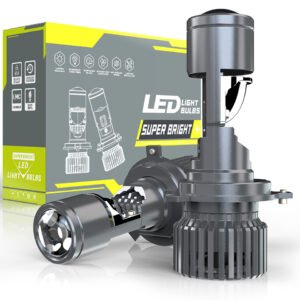What Are Lumen Value and Wattage in LED Car Lights?
When discussing LED car lights, two primary metrics come into play: lumen value and wattage. Lumen value is a measure of the total amount of visible light emitted by a source. In simpler terms, it indicates how bright a light appears to the human eye. For car lights, higher lumen values translate into brighter illumination, which is crucial for enhancing visibility during nighttime driving or under poor weather conditions. Brighter lights ensure drivers can see the road ahead more clearly, including any potential obstacles, which significantly contributes to driving safety.
In contrast, wattage refers to the amount of electrical power consumed by a light source. Historically, incandescent bulbs were rated based on their wattage, which indirectly indicated their brightness. However, this method is not as applicable to modern LED technology. LED lights are designed to be highly energy-efficient, producing a greater amount of light with less power consumption. Consequently, in the context of LED car lights, the emphasis has shifted from wattage to lumens as the key indicator of performance and effectiveness.
Understanding the balance between lumens and wattage is essential when selecting LED car lights. A high lumen value ensures that drivers have adequate illumination, which is especially important in ensuring safety on the road. Conversely, a high wattage rating in LED lights often goes hand-in-hand with higher power consumption, which might not always be necessary considering the efficiency of LEDs. Therefore, modern advancements allow LED car lights to deliver superior brightness (high lumens) without demanding excessive electrical power, thus optimizing both performance and energy efficiency.
In summary, while both lumen value and wattage play pivotal roles in the realm of LED car lights, the modern approach emphasizes lumens over wattage due to the superior efficiency of LED technology. Efficient LED lights with high lumens and optimized wattage not only minimize energy consumption but also maximize driving safety by providing optimal road visibility. Hence, when choosing LED car lights, focusing on the lumen value is crucial for ensuring that the lights are both bright enough and energy-efficient.
Benefits and Considerations of High Lumen and High Wattage LED Car Lights
High lumen and high wattage LED car lights provide numerous advantages over traditional halogen or incandescent bulbs, making them a popular choice among drivers seeking improved performance and safety. One of the most significant benefits is their superior brightness. High lumen LED car lights offer a significantly higher light output, which substantially enhances nighttime driving visibility. This enhanced illumination translates to better recognition of road signs, obstacles, and other vehicles, thereby reducing the risk of accidents and improving overall driving safety.
Another notable advantage of high wattage LED car lights is their longer lifespan. Traditional bulbs have a much shorter operational life, often requiring frequent replacements. In contrast, LEDs are designed to last tens of thousands of hours, which means they are more cost-effective in the long run due to reduced maintenance and replacement costs. Furthermore, LED lights are known for their energy efficiency. They consume less power than halogen and incandescent bulbs, thus reducing the strain on a vehicle’s electrical system and contributing to better fuel efficiency in the long haul.
Enhanced visibility and energy efficiency also play a critical role in reducing driver fatigue, as high lumen output ensures that drivers can see more clearly and respond more quickly to potential hazards on the road. Nonetheless, when choosing LED car lights, it is essential to consider potential drawbacks, such as glare. Excessively bright lights can dazzle other drivers, increasing the risk of accidents. Therefore, it’s vital to ensure that the LED lights are properly aimed and meet road safety regulations to minimize glare and comply with legal standards.
It’s also important to dispel the common misconception that higher wattage always equates to better performance. While higher wattage can contribute to greater brightness, too much wattage can lead to excessive heat generation, which can negatively impact the lifespan and efficiency of the LED lights. A balanced approach, considering both lumens and wattage, is essential for optimal performance. By carefully selecting LED car lights that encompass the right balance of lumen output and wattage, drivers can enjoy superior illumination and safety benefits without compromising energy efficiency or compliance with road safety standards.









lgqw212@gmail.com –
The lights are very bright, the light is stable, and the heat dissipation effect is good. The car is great for night driving after upgrading and modification.